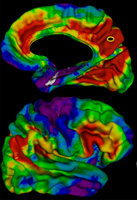Archived Content
The National Institute of Mental Health archives materials that are over 4 years old and no longer being updated. The content on this page is provided for historical reference purposes only and may not reflect current knowledge or information.
Linked Brain Centers Mature in Sync
Imaging Reveals Underlying Unity Between Brain Structure and Development
• Science Update
Long-term neuroimaging studies show for the first time that areas of the brain that are wired together structurally and functionally also tend to mature in tandem over the course of development. The finding adds a new dimension to a picture that is emerging of how structure, function, and development of the brain are intertwined.
Background
Studies of brain development have shown that growth across the brain is not steady and uniform; some areas mature more quickly than others. These studies to date have not, however, examined whether areas of the brain that are linked functionally also develop in a coordinated way. It’s a challenging question because the developmental changes in brain anatomy that can be detected by neuroimaging unfold very slowly. Also, tempos of anatomical change differ from person to person, so comparing brain dimensions in different individuals at the same age can be misleading. The only way to approach this question is to track patterns of growth in the same individuals over many years.
This Study
To address this question, Armin Raznahan and colleagues at NIMH took advantage of a dataset that is unique in the world, consisting of records of brain growth measured by magnetic resonance imaging (MRI) of individuals from childhood to young adulthood. They studied changes in thickness of the outer layer of the brain, the cortex. In order to look for correlated anatomical change in connected parts of the brain, these investigators used records of cortical thickness from 108 individuals from ages 9 to 22. They focused on a well-defined and documented brain circuit: the default mode network or DMN. The DMN, a network identified by functional brain imaging, consists of nodes, or centers, in the brain that are active when someone’s mind is at rest, but quiet when the mind is focused on a task. In addition to tracking growth in the DMN, the NIMH investigators also looked at patterns of growth on the right and left side of the brain. There are extensive neuronal connections between the right and left hemispheres of the brain. Activation tends to be symmetrical and simultaneous within analogous parts on either side of the brain.
Results showed that there was a marked correlation in the rates of cortical thickness change between different points within the DMN when compared with the average correlation among thousands of other points across the brain. A similar pattern was seen among points in a second “task positive” network that is active while someone is carrying out goal-directed tasks; rates of change in cortical thickness within this second network also showed a pattern of coordinated maturing. Parts of the cortex involved in the integration and processing of incoming information and responses—the association cortex—were most likely to show correlated anatomical change with broad areas of the cortex. Similar correlations in change were not seen among parts of the cortex involved primarily in sensory input.
Correlations in anatomical change were also apparent between analogous centers on the right and left side of the brain, paralleling the symmetry in activation of these areas. Finally, the investigators looked at an area of the cortex (the frontopolar cortex) for which previous work had shown differences in the rate of maturation between males and females. This study found the same difference between males and females in maturation rate in this area. In addition, there were differences between the sexes in the degree to which thickness change in this area showed coordination with that of other areas of the cortex.

Significance
Neuroscientists are increasingly viewing the brain in terms of the development and function of neural circuits. According to Dr. Raznahan, this approach represents a sea change compared to the earlier emphasis on studying individual brain areas. In addition to the work reported here, recent studies of gene expression (activity) patterns in the brain suggest that genes that have roles in laying down connections between functionally related areas are also especially active during development.
In a high percentage of cases of mental disorders, the first symptoms emerge during youth; this is one piece of evidence that mental illnesses are disorders of development. Research on the relationships between brain connectedness and structural maturation can help provide a basis for future studies of how disruptions in the laying down of neural circuits in the brain during development can shape the structure and function of the adult brain and set the stage for mental illness. The authors point out in their paper that disorders that disrupt functional connections might also alter structural brain development. Comparing how development unfolds in individuals with and without disorders of mental health can offer clues to causes and targets for therapies. Finally, the findings on sex differences reported here can lend insight into the types of behavior seen during adolescence, especially risk-taking.
Reference
Raznahan, A., Lerch, J.P., Lee, N., Greenstein, D., Wallace, G., Stockman, M., Clasen, L., Shaw, P., and Giedd, J. Patterns of coordinated anatomical change in human cortical development: a longitudinal neuroimaging study of maturational coupling. Neuron. 2011 Dec 8;72(5):873-84.
